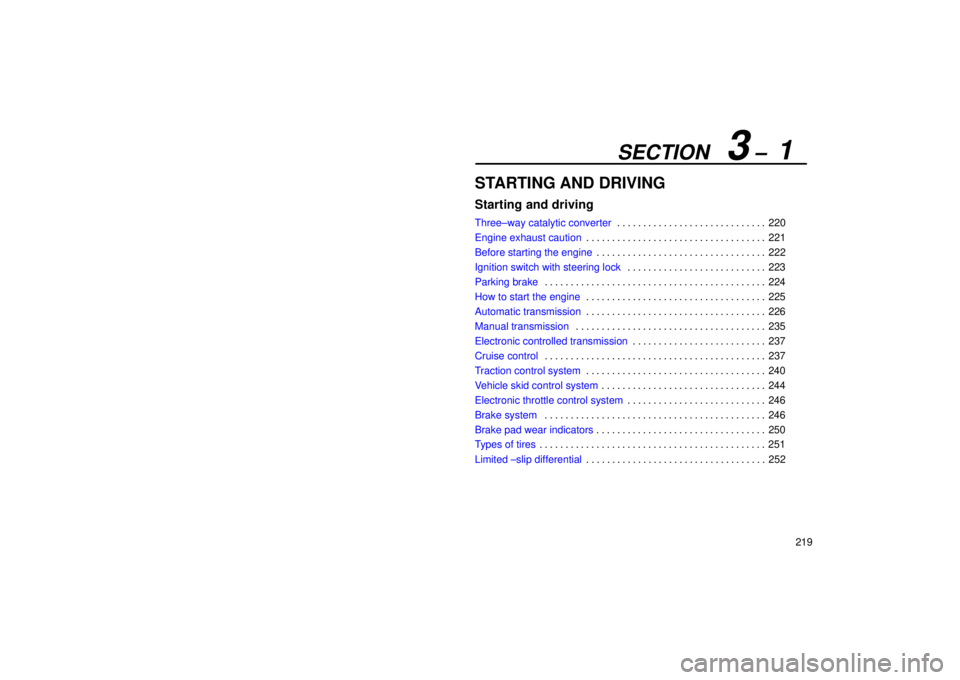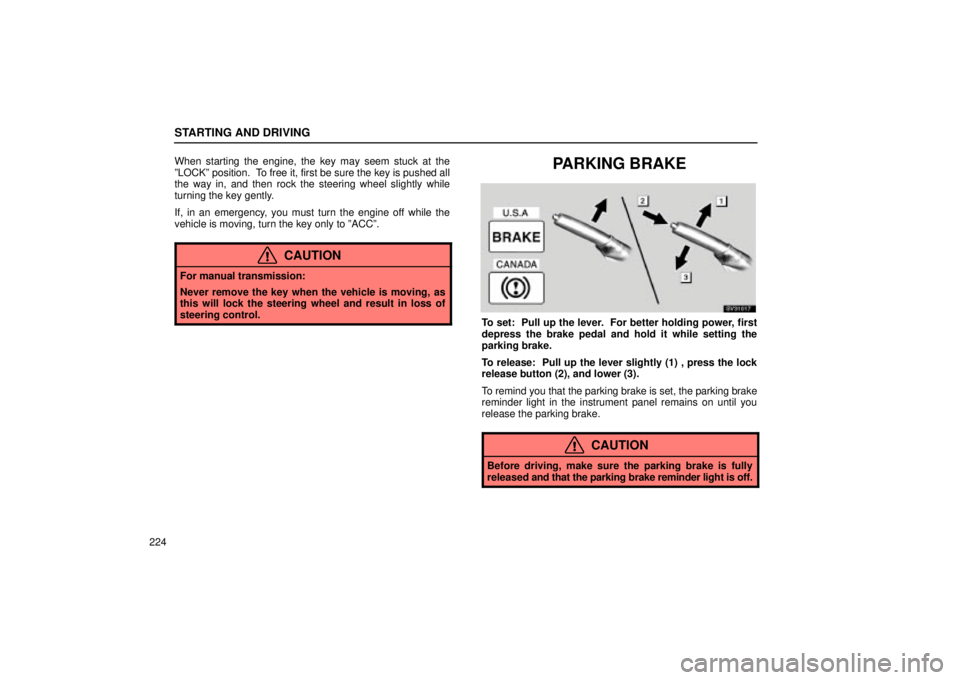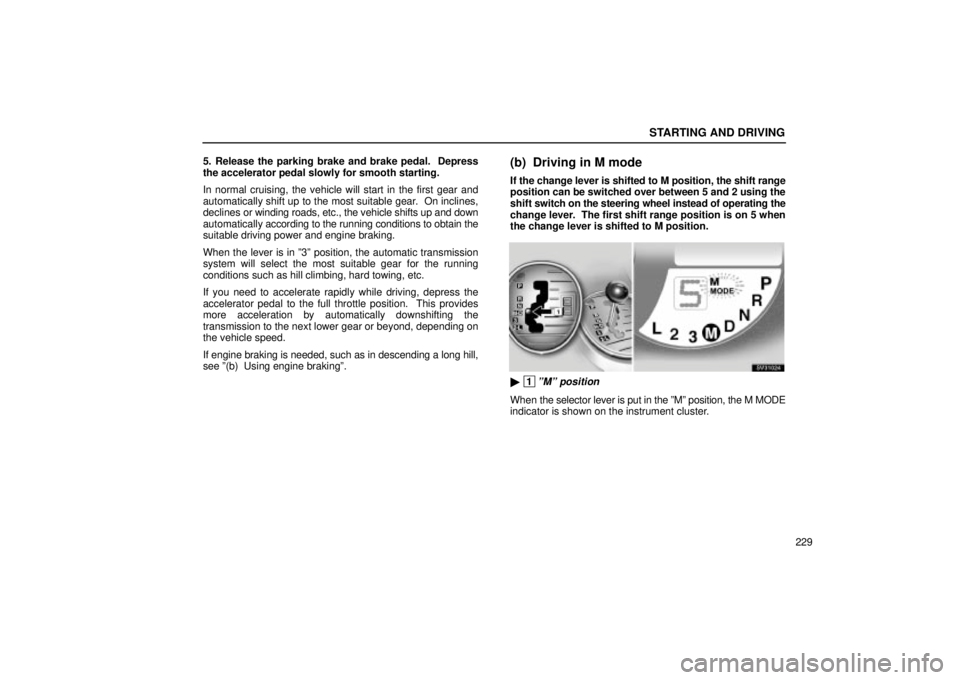Page 232 of 378

SECTION 3 ± 1
219
STARTING AND DRIVING
Starting and driving
Three±way catalytic converter220
. . . . . . . . . . . . . . . . . . . . . . . . . . . . .
Engine exhaust caution 221
. . . . . . . . . . . . . . . . . . . . . . . . . . . . . . . . . . .
Before starting the engine 222
. . . . . . . . . . . . . . . . . . . . . . . . . . . . . . . . .
Ignition switch with steering lock 223
. . . . . . . . . . . . . . . . . . . . . . . . . . .
Parking brake 224
. . . . . . . . . . . . . . . . . . . . . . . . . . . . . . . . . . . . .\
. . . . . .
How to start the engine 225
. . . . . . . . . . . . . . . . . . . . . . . . . . . . . . . . . . .
Automatic transmission 226
. . . . . . . . . . . . . . . . . . . . . . . . . . . . . . . . . . .
Manual transmission 235
. . . . . . . . . . . . . . . . . . . . . . . . . . . . . . . . . . . . .\
Electronic controlled transmission 237
. . . . . . . . . . . . . . . . . . . . . . . . . .
Cruise control 237
. . . . . . . . . . . . . . . . . . . . . . . . . . . . . . . . . . . . .\
. . . . . .
Traction control system 240
. . . . . . . . . . . . . . . . . . . . . . . . . . . . . . . . . . .
Vehicle skid control system 244
. . . . . . . . . . . . . . . . . . . . . . . . . . . . . . . .
Electronic throttle control system 246
. . . . . . . . . . . . . . . . . . . . . . . . . . .
Brake system 246
. . . . . . . . . . . . . . . . . . . . . . . . . . . . . . . . . . . . .\
. . . . . .
Brake pad wear indicators 250
. . . . . . . . . . . . . . . . . . . . . . . . . . . . . . . . .
Types of tires 251
. . . . . . . . . . . . . . . . . . . . . . . . . . . . . . . . . . . . .\
. . . . . . . Limited ±slip differential
. . . . . . . . . . . . . . . . . . . . . . . . . . . . . . . . . . . 252
Page 237 of 378

STARTING AND DRIVING
224When starting the engine, the key may seem stuck at the
ºLOCKº position. To free it, first be sure the key is pushed all
the way in, and then rock the steering wheel slightly while
turning the key gently.
If, in an emergency, you must turn the engine off while the
vehicle is moving, turn the key only to ºACCº.
CAUTION
For manual transmission:
Never remove the key when the vehicle is moving, as
this will lock the steering wheel and result in loss of
steering control.
PARKING BRAKE
SV31017
To set: Pull up the lever. For better holding power, first
depress the brake pedal and hold it while setting the
parking brake.
To release: Pull up the lever slightly (1) , press the lock
release button (2), and lower (3).
To remind you that the parking brake is set, the parking brake
reminder light in the instrument panel remains on until you
release the parking brake.
CAUTION
Before driving, make sure the parking brake is fully
released
and that the parking brake reminder light is off.
Page 238 of 378

STARTING AND DRIVING
225
HOW TO START THE ENGINE
Before cranking
1. Apply the parking brake firmly.
2. Turn off unnecessary lights and accessories.
3.Manual transmission : Press the clutch pedal to the floor
and shift the transmission into neutral. Hold the clutch pedal
to the floor until the engine is started. A starter safety device
will prevent the starter from operating if the clutch pedal is not
fully depressed.
Automatic transmission : Put the selector lever in ºPº. If you
need to restart the engine while the vehicle is moving, put the
selector lever in ºNº. A starter safety device will prevent the
starter from operating if the selector lever is in any drive
position.
4. For automatic transmission only :Depress the brake
pedal and hold it to the floor until driving off.
Starting the engine
Before starting the engine, be sure to follow the instructions in
ºBefore crankingº.
Normal starting procedure
The multiport fuel injection system/sequential multiport fuel
injection system in your engine automatically controls the
proper air±fuel mixture for starting. You can start a cold or hot
engine as follows:
1. With your foot off the accelerator pedal, crank the engine by
turning the key to ºSTARTº. Release it when the engine starts. 2. After the engine runs for about 10 seconds, you are ready
to drive.
If the weather is below freezing, let the engine warm up for a
few minutes before driving. Do not leave the vehicle while the
engine is warming up.
If the engine stalls ...
Simply restart it , using the correct procedure given in normal
starting.
If the engine will not start
See ºIf your vehicle will not startº on page 263.
NOTICE
�Do not crank for more than 30 seconds at a time. This
may overheat the starter and wiring systems.
�Do not race a cold engine.
�If the engine becomes difficult to start or stallsfrequently, have the engine checked immediately.
Page 239 of 378
STARTING AND DRIVING
226
AUTOMATIC TRANSMISSION
Your automatic transmission has a shift lock system to
minimize the possibility of incorrect operation. This
means you can only shift out of ºPº position when the
brake pedal is depressed with the ignition switch in ºONº
position. (�)
SV31020
�The shift position is displayed on the instrument
cluster.
P: Parking, engine starting and key removal position
R: Reverse position
N: Neutral position
D: Normal driving position (Shifting into overdrive
possible)
M: Position for manual shifting up or downshifting
When the cruise control is being used, even if you
downshift from º5º to º4º, engine braking will not be
enabled because the cruise control is not cancelled. For
the operation to decrease the vehicle speed, see page
239.
3, 2: Position for more powerful engine braking
L: Position for maximum engine braking
Page 242 of 378

STARTING AND DRIVING
229
5. Release the parking brake and brake pedal. Depress
the accelerator pedal slowly for smooth starting.
In normal cruising, the vehicle will start in the first gear and
automatically shift up to the most suitable gear. On inclines,
declines or winding roads, etc., the vehicle shifts up and down
automatically
according to the running conditions to obtain the
suitable driving power and engine braking.
When the lever is in º3º position, the automatic transmission
system will select the most suitable gear for the running
conditions such as hill climbing, hard towing, etc.
If you need to accelerate rapidly while driving, depress the
accelerator pedal to the full throttle position. This provides
more acceleration by automatically downshifting the
transmission to the next lower gear or beyond, depending on
the vehicle speed.
If engine braking is needed, such as in descending a long hill,
see º(b) Using engine brakingº.
(b) Driving in M mode
If the change lever is shifted to M position, the shift range
position can be switched over between 5 and 2 using the
shift switch on the steering wheel instead of operating the
change lever. The first shift range position is on 5 when
the change lever is shifted to M position.
SV31024
� 1ºMº position
When the selector lever is put in the ºMº position, the M MODE
indicator is shown on the instrument cluster.
Page 246 of 378
STARTING AND DRIVING
233
(e) Backing up
SV31025
� 1Brake pedal 2ºRº (Reverse) position
1. Bring the vehicle to a complete stop.
2. With the brake pedal held down with your foot, shift the
selector lever to the ºRº position.
NOTICE
Never shift into reverse while the vehicle is moving.
(f) Parking
SV31026
� 1Brake pedal 2Parking brake lever
3ºPº (Park) position
1. Bring the vehicle to a complete stop.
2. Pull the parking brake lever up fully to securely apply the
parking brake.
3. With the brake pedal held down with your foot, shift the
selector lever to the ºPº position.
CAUTION
Never attempt to move the selector lever into ºPº under
any circumstances while the vehicle is moving. Serious
mechanical damage and loss of vehicle control may
result.
Page 247 of 378

STARTING AND DRIVING
234
(g) Good driving practice
If the transmission repeatedly shifts up and down between the
fourth and overdrive gears when climbing a gentle slope, shift
the selector lever to the ºMº position and select the fourth gear
by pushing the transmission switch. Be sure to shift the
selector lever to the ºDº position after climbing the slope.
CAUTION
Always keep your foot on the brake pedal while stopped
with the engine running. This prevents the vehicle from
creeping.
NOTICE
Do not hold the vehicle on an upgrade with the accelerator pedal. This can cause the transmission tooverheat. Alw ays use the brake pedal or parking brake.
(h) Rocking your vehicle if stuck
CAUTION
If your vehicle becomes stuck in snow, mud, sand, etc.,
then you may attempt to rock the vehicle free by moving
it forward and backward. Do not attempt this procedure
if people or objects are anywhere near the vehicle.
During the rocking operation the vehicle may suddenly
move forward or backward as it becomes un±stuck,
causing injury or damage to nearby people or objects.
NOTICE
If you rock your vehicle, observe the following precautions to prevent damage to the transmission and
other parts.
�Do not depress the accelerator pedal while shifting the selector lever or before the transmission iscompletely shifted to forward or reverse gear.
�Do not race the engine and avoid spinning thewheels.
�If your vehicle remains stuck after rocking the vehicleseveral times, consider other ways such as towing.
Page 248 of 378

STARTING AND DRIVING
235
(i) If you cannot shift the selector
If you cannot shift the selector lever even though the brake
pedal is depressed, use the shift lock override button. For
instructions, see ºIf you cannot shift automatic transmission
selector leverº on page 284.
(j) If the ºECT PWRº indicator light flashes
If the ºECT PWRº indicator light flashes, contact your Lexus
dealer as soon as possible. There may be trouble in the
transmission system.
MANUAL TRANSMISSION
SV31034
The shift pattern is the conventional pattern shown above.
Press the clutch pedal down fully while shifting, and then
release it slowly. Do not rest your foot on the pedal while
driving, because it will cause clutch trouble. And do not use the
clutch to hold the vehicle when stopped on an uphill grade ±
use the parking brake.
Upshifting too soon or downshifting too late will cause lugging,
and possibly pinging. Regularly revving the engine to
maximum speed in each gear will cause excessive engine
wear and high fuel consumption.
Recommended shifting speeds
The transmission is fully synchronized and upshifting or
downshifting is easy.
For the best compromise between fuel economy and vehicle
performance, you should upshift or downshift at the following
speeds: